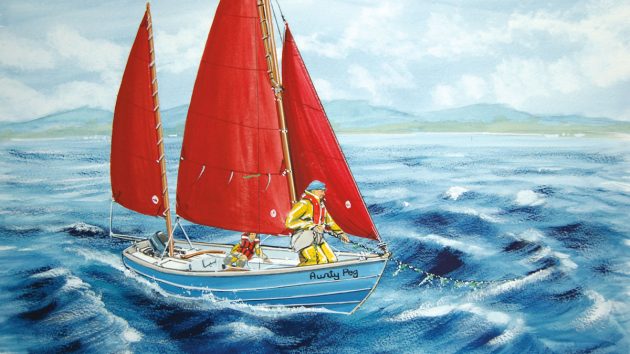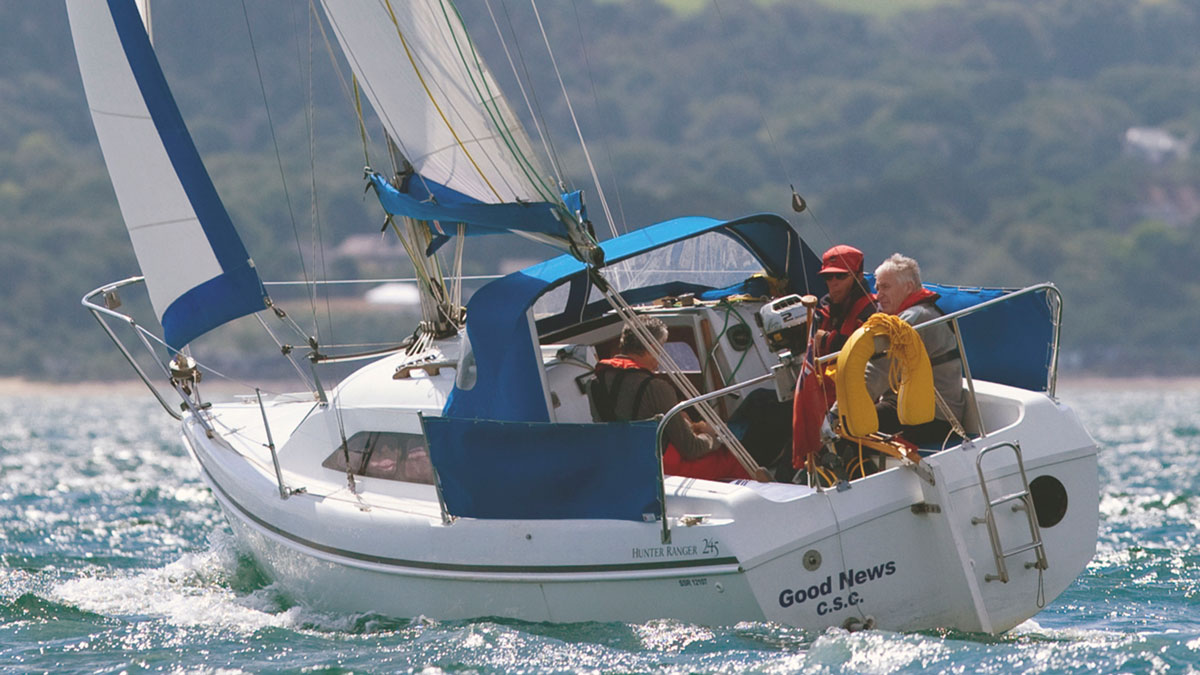Peter Kersey draws on the wisdom of an old smack sailor to get his engineless Drascombe Lugger out of trouble off a lee shore
While we were in the Isles of Scilly, a situation arose with our Drascombe Lugger, Aunty Peg, writes Peter Kersey
We’d sailed round the north end of Tresco in a light Force 3 north-westerly wind and had anchored off the slip in New Grimsby to visit the shop.
Upon our return, the wind had strengthened to south-westerly, and was now blowing directly onshore with Aunty Peg just 100m offshore and straining at her cable… and the outboard motor steadfastly refused to start!

Peter Kersey started cruising in the 1960s. He has owned several boats including the Albin Ballad, Flute
The options were to try rowing a bit further offshore and then sail, although the wind was quite strong to row against; or try to sail out directly, close-hauled, after raising the anchor, although I was concerned that we might be blown on the shore before storage way could be established; or try to sail out the anchor.
As it happened, I had read Half a Gale by Michael Frost, in which he describes a similar predicament in his East Coast oyster smack, Boadicea in the 1950s.
He had beached her for scrubbing, but when he came to relaunch her a strong onshore wind had blown up, and he was on his own.
I will let him take up the story.
‘After pulling down two reefs in the mainsail ready for hoisting, I brought out the storm jib and bent it. I then sat on deck for a few minutes working out the plan. With the wind onshore, I would have to sail the anchor out in the approved manner, which in itself was no problem. The anxieties would begin at the moment the anchor broke out, because then the smack would be with at least two fathos of chain still to be hauled in and no time to do it.
‘If I tried to sail off the hard before the chain was fully hauled in the anchor was almost bound to pick up at least one dinghy cable or more likely several, and that would spell disaster because I could not hope to clear them in the short time I was able to safely leave the smack with her helm unattended. If only the wind would lull, that would more than double the time I could afford to stay up forward. A hopeful glance at the sky to windward showed me that reprieve was unlikely so, making the best of a bad job, I decided I would just have to get the anchor to the davit as best I could.
‘With nothing to be gained by waiting, I set up the mainsail and sheeted it in to about the close-hauled position. The moment of starting could not be delayed much longer but, still hoping for a lull, I paused to study the lie of the boats round the smack and plan my route of exit.
‘While doing this I saw Juggens (an old smacks man) sculling off (towards me). He was still on the far side of the causeway, and although already well out in the creek he was heading into the wind using long powerful strokes of his sculling oar. With the urgency of the situation now gone, I watched with a glow of gratitude.
‘As I expected, he swung his boat’s head round and then, with the wind over her quarter, swept down towards the smack. He rounded up alongside and, in a single flowing movement, laid down his oar and gathered up his painter as he came aboard. After letting the boat go aft he made her fast and then strode up to the foredeck, timing it so he could ignore the boom altogether. He glanced round quickly and then told me the sooner the smack was off the hard, the better. He said this in a conversational tone, and in these surroundings, his voice had the clarity an orator might have envied. Quite unperturbed by the noise and the wind, he pointed out the avenue the smack must take on her way out and then, in his quick way of talking, went on to add: “Shorten in your chain by half and sheet the jib to starboard. She’ll do the rest herself.” To my astonishment, he then strode aft and pulled in his boat. A moment later he was gone.
‘My first reaction was swingeing disappointment. The help I so much needed had come to nothing. Juggens was now sculling up to weather not far away, and perhaps realising my dismay he raised his hand and called across: “Shorten your chain.” I began to realise that by coming off he had changed the situation. I was no longer a tyro taking foolish risks, but was instead a pupil doing as I was told. I began to understand why he had come off and why he had not stayed. I raised a hand in reply and began hauling in.
‘When I had shortened in the chain I sheeted the jib to starboard as he had told me and, answering to the pull of it, the smack payed away easily, hove to on the starboard tack. The furious slamming of the mainsail stilled as though by magic, and moving slowly forward the smack began fore-reaching southwards, ranging to her anchor. For a few moments she continued, and then the chain began checking her as it drew out bar tight, nearly at right-angles to her course.
‘Answering to this new pull she quietly began to luff, and I quickly fleeted the chain across the windlass barrel so as to be ready for hauling in after she wended. She came round easily, and with her jib now drawing she was sailing on this tack without curb. She headed away west by north with the chain coming slack beneath her. Now was the time to shorten in again, and with the windlass pawls ringing merrily, I hove in by hand, taking in the slack as she won it for me.
‘Soon would come the question as to when I should stop hauling, and this was something I had to judge for myself. The lie of the chain was straight ahead and clearly I must break out the anchor as the smack wended this time but, just as importantly, I must on no account break it out before it brought her round. I stopped hauling at what I hoped was the right moment, and a second later the smack snubbed sharply. She came round to lie hove to again, and now I had to haul in at full stretch. At all costs the anchor must be broken out before she snubbed again. The chain was coming home too easily, and something was desperately wrong. It dawned on me that somehow I had misjudged things badly. At that moment the chain did snub, with a force that winded me. The anchor was in the davit.
‘Collecting my wits, I took stock of the situation and felt a wave of relief. Juggens had said the smack would do the rest herself, and she was indeed doing just that. Fore-reaching down the lane he had indicated, she needed no help from me, and I simply stood by watching her.’
The Juggens manoeuvre

How to execute the Juggens manoeuvre
Realising there were similarities in my predicament to Frost’s description, I determined to try out ‘the Juggens manoeuvre’.
Accordingly, I raised the mainsail and tightened the mainsheet to the close-hauled position and then backed the jib, leaving the tiller free.
As described, he boat fore-reached and then snubbed and luffed onto the port tack.
As the chain slackened, I hauled it in until she snubbed and tacked again back to the starboard tack and hove-to position.
More chain came in, and with it the anchor. Aunty Peg fore-reached until the jib sheet was released and the sail began to draw.
Meanwhile, an Island Pilot lying near us tried to sail off directly, but was blown sideways before steerage way could be made and was blown onto the lee shore.
Lessons Learned
- I was impressed that a Drascombe Lugger would respond in the same way as much larger and heavier smacks, and also deeply impressed by the skills of the old oystermen who sailed without engine in all weathers.
- I would recommend the ‘Juggens manoeuvre’ to all Drascombers in similar circumstances. If nothing else, it is a great deal of fun to do.
- I would also recommend Half a Gale by Michael Frost, which is full of salty sailing wisdom. The book is out of print, but often available online.
Continues below…
Drascombe & Devon Lugger vs the Dabber
Designed for safe family boating under sail, or or power, but taken long distance by intrepid sailors, Clive Marsh looks…
Drascombe and Devon Luggers buyer’s guide: Gateway to offshore sailing
Visit any UK harbour in the summer and the chances are you’ll see a Drascombe Lugger or a Devon Lugger…
Nautical know-how: The Bernoulli principle
Andrew Morton describes the Bernoulli principle and its effect on manoeuvring in tight spaces in a motorboat
Sailing without an engine: tips to get home when it fails
Faced with an engine that won’t work, do we necessarily have to reach for the radio to summon help? Depending…
Enjoyed reading The Juggens manoeuvre to get you off a lee shore?

A subscription to Practical Boat Owner magazine costs around 40% less than the cover price.
Print and digital editions are available through Magazines Direct – where you can also find the latest deals.
PBO is packed with information to help you get the most from boat ownership – whether sail or power.
-
-
-
- Take your DIY skills to the next level with trusted advice on boat maintenance and repairs
- Impartial in-depth gear reviews
- Practical cruising tips for making the most of your time afloat
-
-
Follow us on Facebook, Instagram, TikTok and Twitter








